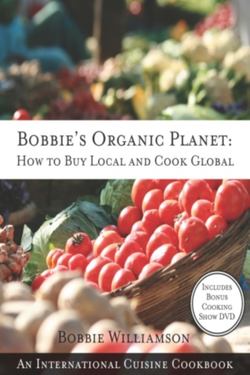Читать книгу Bobbie's Organic Planet - Bobbie Williamson - Страница 11
На сайте Литреса книга снята с продажи.
Herbs and Edible Flowers
ОглавлениеHERBS
Fresh herbs enhance the flavors of any dish and are also used as garnishes. They are what make basic foods come alive. Fresh herbs are more delicate than dried herbs but add more flavor. The general rule of thumb is to substitute fresh herbs for dried ones in a ratio of 3 to 1. That is, use three times as much fresh herbs as you would dried herbs.
Fresh herbs should not be cooked for long and should be added at the end of the cooking process, as they can become bitter. Make sure your herbs are organic and planted in organic soil. Herbs have no protective skins, so any pesticides will be impossible to rinse off. Also, the organic variety will give you far more nutrients. Herbs are not just for flavor but have been used for medicinal purposes, fragrances, and sorcery for centuries. Most culinary herbs are indigenous to the Mediterranean region and thus require direct sunlight.
Experiment with fresh herbs and find what combinations best suit your palette. Borage grown near tomatoes gives the latter more taste and is great added to salads and soups. Adding fresh mint to butter beans or May peas is a great substitute for salt and pepper. Mint is also commonly paired with roast lamb in the Middle East and in England. Basil complements a fresh tomato salad, as does flat-leaf parsley. Lavender can make a normal butter cookie an exotic one for a tea party. Dill makes for a tasty garnish on freshly grilled salmon. Chives added to sour cream give a natural bite. Cilantro is commonly found in Asian, Italian, and Mexican cuisine.
Rosemary and fresh mint grow easily in the South, where I live, so I tend to use these two herbs often in my kitchen, as they proliferate wildly in my garden. Freshly cut rosemary placed in a small vase adds a delicious fragrance to my kitchen. I often add mint leaves to herbal teas in the summertime to make a great iced tea.
Herbes de Provence (provincial herbs) is an aromatic blend of herbs from the south of France. Rosemary, basil, oregano, marjoram, thyme, fennel, and sage are the traditional blend. My favorite one incorporates fresh lavender. Herbes de Provence is typically used in dishes from the Mediterranean and complements salads, chicken, lamb, and fish. This blend makes for a great rub combined with olive oil. My kitchen is never without a great quantity, and it sets any dish apart. My children religiously send me fresh supplies, or I buy my stash when visiting them in Europe.
Herbes de Provence is easily available in most grocery stores now. However, it is a rather pricey commodity outside of Europe. Here is a recipe that is easily made at home. The traditional manner of storing it is in terracotta jars, but glass ones will do fine, as well. This makes for a great gift to any host or hostess entertaining you.
Herbes de Provence Makes 1/3 cup
1 tablespoon dried rosemary
1 tablespoon dried thyme
1 tablespoon dried sage
1 teaspoon dried lavender
1 teaspoon dried tarragon
1 teaspoon dried marjoram
1/2 teaspoon dried oregano
1/2 teaspoon dried mint
2 teaspoons dried crushed bay leaves
Mix together all of the ingredients and store in a terra cotta container or glass jar.
Za’atar is an Arabic term referring to any various local herbs of the mint family, including marjoram, oregano, and thyme. Green za’atar mixture is traditionally composed of dried thyme, toasted white sesame seeds, and sea salt. Red za’atar is made with dried thyme with sumac. Sumac is commonly found in Middle Eastern stores, or it can be ordered online.
The following recipe is simple and tasty.
Za’atar
3 tablespoons toasted sesame seeds
2 tablespoons dried thyme
1 tablespoons dried marjoram
_ - 1 tablespoon powdered sumac
Mix ingredients together in a small bowl. Store in a glass jar away from light.
Here is a list of commonly grown fresh herbs to be added to your cuisine:
Basil
Bay Leaves
Borage
Chives
Cilantro
Dill
Fennel
Flat-leaf parsley
Lavender
Marjoram
Mint
Oregano
Rosemary
Sage
Tarragon
Thai basil
Thyme
EDIBLE ORGANIC FLOWERS
Edible flowers are perhaps my favorite living food decoration of all. Flowers are beautiful to look at in a vase, but try putting them atop a salad or interspersed on your hors d’oeuvres tray, and such a joyful and tasty touch is added. Just as said, they are truly edible. Do you remember as a kid finding a honeysuckle bush and sucking the nectar from its flowers?
It is easy to plant your own edible flowers in rows in your garden or just in clay pots. To be edible flowers, they must be grown in organic soil. You must never collect them by the side of the road or buy them at the florists, for neither of these sources will provide safe flowers to eat. Wash the petals well and cut off the stems. Many organic markets sell these little delights and some grocery stores stock them too, but give growing your own a try.
Not everyone likes the taste of flowers, so use them sparingly at first and find out which ones are suitable to your family. My personal favorites are nasturtium, pansies, and honeysuckle. Nasturtiums have a slight peppery taste and come in many hues. They also grow easily. Pansies are varied in color, as well, and honeysuckle is delicate and sweet, just like honey.
Listed below is a variety of common edible flowers you can choose from; however, there are many more. Look on the Internet to find a complete list.
Apple blossoms
Apricot petals
Bean Blossoms
Begonia
Calendula
Carnations
Clover
Dandelions
Daylilies
Geraniums
Honeysuckle
Johnny-Jump-Ups
Lavender
Marigolds
Nasturtiums
Pansies
Peach blossoms
Pear blossoms
Peonies
Primrose
Squash Blossoms
